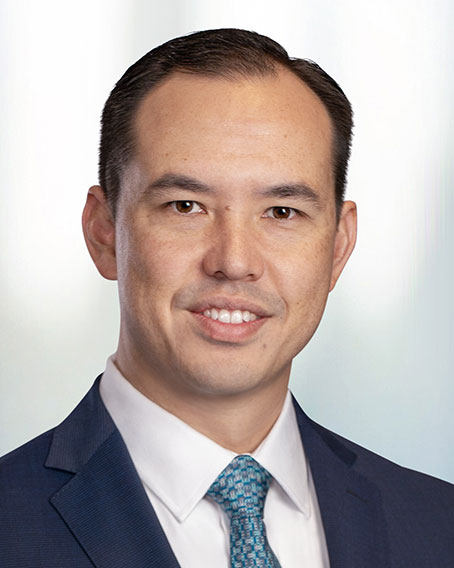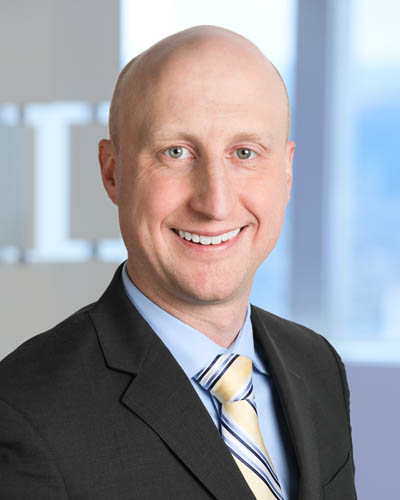Ropes & Gray’s podcast series Conductive Discussions focuses on legal issues of interest to the semiconductor industry. In this episode, IP litigation partners Mark Rowland and Andrew Radsch, and associates Daniel Richards and James Mack, discuss patent infringement under section 271(g) of the Patent Act, a frequently overlooked but powerful provision. The team explores the statutory exceptions to liability, the availability of burden-shifting when proving infringement, and unique damages limitations for claims under section 271(g).
Transcript:
Mark Rowland: Welcome to this episode of Conductive Discussions, a Ropes & Gray podcast series focused on legal issues of interest to the semiconductor industry. My name is Mark Rowland, and I'm a partner at Ropes & Gray in our IP litigation practice, based in our Silicon Valley office. I'll be hosting this episode. Today, we'll focus on an area of U.S. patent law that relates to manufacturing processes. This area of law is important to anyone who fabricates or assembles products inside or outside of the United States. It is also important to anyone who imports or sells in the United States, products that were made inside or outside the United States. 35 U.S.C. 271 is the statute that lists the ways in which a U.S. patent can be infringed. The last paragraph of that statute, paragraph (g), is not as commonly the subject of litigation as the paragraphs before it, but it can be a trap for the unwary, because it can create liability for an importer or seller of a product if a manufacturing process used by any other party in making the product has been patented in the U.S., regardless of whether the importer or seller knows how the product was made, and regardless of whether the product is made in the U.S. or abroad. You'll be hearing from an exciting group of practitioners on this topic, all of whom have experience with legal matters relating to semiconductors. To start, let me introduce Andrew Radsch, an IP litigation partner in our Silicon Valley office. Welcome, Andrew. Also with me from the Ropes & Gray Silicon Valley office are Daniel Richards and James Mack, associates in our IP litigation practice. Welcome Daniel and James. Daniel will start us off with our Silicon Speak report of recent legal news.
Daniel Richards: Thanks, Mark. In semiconductor industry news, we have several developments relating to where our chips are being manufactured, whether in the U.S. or outside the U.S., which has the possibility to implicate 271(g):
- First, Intel's incoming CEO recently stated that he “is confident that the majority of [Intel's] 2023 products will be manufactured internally,” but at the same time, “it is likely that [Intel] will expand its use of external boundaries for certain technologies and products.”
- Second, last month the auto industry announced that it's facing a global shortage of semiconductors for auto parts, which is forcing it to halt or slow production. Taiwan Semiconductor is now expediting auto-related products and prioritizing manufacture of these products. Other chip manufacturers have also confirmed that they are prioritizing auto-related products.
- And finally, Foxconn has defaulted on its commitment to build a state-of-the-art manufacturing facility in Wisconsin. Development has stalled and it's unclear if or when an operating manufacturing plant will open.
Section 271(g) framework
Mark Rowland: Thanks, Daniel. So now let's turn to a discussion of 35 U.S.C. Section 271(g). First, let's discuss the text of that section. James, what does the statute provide?
James Mack: Well, 35 U.S. Code Section 271(g) provides that it is an act of infringement to import a product that is made abroad by a U.S. process patent. Prior to the enactment of Section 271(g), a manufacturer could often avoid infringing a U.S. process patent by performing the patented process overseas and importing the resulting product into the United States. But now, that is an infringing act under 271(g).
Daniel Richards: Does that mean the U.S. patent applies outside the U.S.?
James Mack: No. Although the patented process is performed abroad, Section 271(g) is not an extraterritorial application of U.S. patent law. Rather, the act of infringement is the act of importation into the United States. It's also interesting to note that Section 271(g) applies to products made within the United States as well, and the infringing act is the sale or use of the product. Following similar reasoning, a 2019 Federal Circuit case, Syngenta, recently clarified that divided infringement is not an issue under 271(g). In other words, the patented process can be performed by multiple entities, and implication of the product can still infringe 271(g). Part of the Federal Circuit's rationale was that the infringing act is the act of importation, not performance of the patented process.
Andrew Radsch: So James, even if no one company performed the patented process, but all of the steps of that process occurred as a product passes from one factory to another during manufacture, the importer or seller of the final product can still be held liable?
James Mack: Yes, that's right, because the infringing act is the importation, and the infringing product is defined as being made by the patented process. But there are two key exceptions to 271(g) liability that are expressly provided for by the statute:
- First, a product is not infringing if, after performing the patented process, the product is materially changed by subsequent processes.
- The Federal Circuit outlined an example of this in a 1996 case involving pharmaceutical manufacturing. There, the patent-in-suit was directed to a process for making an intermediate compound. Four subsequent processes were performed, and each one imparted a different structural change to the molecule. Because of these structural changes, the Federal Circuit held that the final compound that was imported was “materially changed” from the product of the patented process, so that importation did not infringe 271(g).
- And the second statutory exception provides that a product is not infringing if, after being made by the patented process, it becomes a trivial and nonessential component of another product.
- Now, the precise boundaries of this exception are unclear. There have been a few cases where components have been deemed not to fall within the “trivial and nonessential” exception, meaning that the imported product did infringe 271(g). For example, the Northern District of California in the case Hughes Aircraft found that semiconductor chips in ignition modules of imported cars did not fall within the “trivial and nonessential” exception.
- Future case law will need to develop the bounds of this exception further. And unfortunately, the legislative history does not provide an example of a component that would fall within this exception either.
Mark Rowland: James, you mentioned the legislative history. Can you explain whether it helps to understand the scope of 271(g) in any way?
James Mack: Well, the Senate report published prior to enactment of the statute is helpful, and it does provide several examples and some discussion of the intended scope of 271(g). One item the Senate report contains is a comment on how 271(g) might apply to the semiconductor industry.
Mark Rowland: What did that comment say?
James Mack: Well, the report gives the example of a process patent performing a semiconductor structure on a substrate, and the report states that subsequent processing to complete and finish the semiconductor component does not materially change the substrate. The report also states that the cost of a semiconductor component may be trivial in relation to the cost of the whole product, but if the same component is essential to the intended function of the whole product, then importation of the product would be covered by 271(g). Another item that the Senate report describes is a carve-out to the “materially changed” exception. This carve-out provides that if there are no commercially viable alternatives to the patented process, then the imported product is infringing, whether or not it was materially changed by subsequent processes. Now this carve-out to the “materially changed” exception does not appear at all in the text of the statute itself, but the Federal Circuit and some district courts have found it to assist in interpreting the “materially changed” clause, although not to be definitive.
Mark Rowland: But do the courts go so far as to read the carve-out into the statute?
James Mack: Courts have not gone quite that far. The Federal Circuit found that the carve-out did not apply to the case at hand, although they did go on to analyze how the carve-out would be interpreted if it did apply. And in a 2010 case, Flexsys America v. Kumho, the Northern District of Ohio did use the Senate report's explanation of the carve-out, but found that there was material change, so they avoided relying on the carve-out. And so as we have just briefly touched on, these two exceptions are not always easy to apply. In cases where these exceptions are key issues, both the plaintiffs and defendants will find that the relative paucity of case law and the somewhat abstruse legislative history might make fertile ground for creative new arguments on the scope of 271(g).
Proving infringement under Section 271(g)
Mark Rowland: Thanks, James. With that framework in mind, let's shift to issues that may come up with litigating infringement under 35 U.S.C. Section 271(g). First, it's easy to imagine that it could be difficult to figure out what process was used to make an imported product, even for the importer or seller. There's another statute that Congress passed relating to proving infringement of a process patent, 35 U.S.C. Section 295. Daniel, talk to us about the interplay between Section 271(g) and Section 295.
Daniel Richards: Definitely. We've seen some cases with infringement allegations based on 271(g) filed recently, so now's a good time to keep in mind the relevance of Section 295. Section 295 is a burden-shifting provision under which, if a plaintiff can prove, (1) a substantial likelihood exists that the product was made by the patented process, and, (2) the plaintiff made a reasonable effort to determine the process actually used, but was unable to so determine, the plaintiff gets a presumption that the patented process was used. That's a pretty big deal. Think about this scenario: A defendant is accused of infringement because they sell a product manufactured using an accused process. The manufacturer is not forthcoming with details about the manufacturing process, and the plaintiff persuades the court that the presumption in Section 295 should apply. The defendant now has to prove it does not infringe—not the other way around.
Andrew Radsch: Yes, that's a pretty stark impact. Daniel, how are we seeing Section 295 come up in cases?
Daniel Richards: Sure. We've seen 295 presumption applied in some recent cases. For example, the district court in the Syngenta case that James mentioned earlier actually applied this presumption, and the jury issued a specific verdict in the patentee Syngenta’s favor as a result.
James Mack: Has the presumption been applied in a semiconductor case?
Daniel Richards: We haven't seen the presumption applied yet recently in a semiconductor case, but with offshore, third-party fabs increasingly being used to manufacture semiconductor components, you can imagine that it's only a matter of time until this happens and it impacts the course of litigation.
Mark Rowland: What kinds of issues have been coming up when a plaintiff seeks to gain the benefit of Section 295 and its presumption?
Daniel Richards: Well, there have been a couple of helpful data points about how the 295 presumption comes into play in practice. The most recent is an informative case last year out of the Eastern District of Texas: RevoLaze v. J.C. Penney. That case raises some very interesting litigation strategy issues. In that case, RevoLaze sought leave to amend its infringement contentions to, among other things, allege that Section 295 applies. Judge Gilstrap denied that motion with respect to that request. As Judge Gilstrap recognized, the Section 295 burden-shifting mechanism can significantly impact discovery strategies, as the defendant may have to conduct discovery into its own manufacturers if it faces the risk of being burdened with the 295 presumption. Thus, because the patent team didn't identify a 295 theory in its contentions early on, it was foreclosed from relying on its burden-shifting mechanism. Second, some of the district court cases addressing whether to apply Section 295 are worth paying attention to because they highlight some potential hurdles that may be confronted when applying Section 295. For example, the district court decision in Syngenta, which found that 295 applied, considered whether other non-infringing methods could also be used to manufacture the accused products in deciding whether there was a substantial likelihood that the patented process had been used, which, of course, is the first threshold requirement that must be met before the burden-shifting of Section 295 applies. This is in line with earlier cases, like a 2010 case in Delaware, where the court took into consideration other methods of manufacture that would not infringe in declining to apply Section 295. These cases also bear out the importance of considering how the plaintiff will prove up infringement. This includes testing, written and deposition discovery and identifying documentation that the accused method was actually used to manufacture the accused product.
James Mack: Interesting. So in the semiconductor space, this could pose a real strategy issue for litigants.
Daniel Richards: Exactly. For plaintiffs and defendants alike, when litigating manufacturing method claims, where the method is performed by a third party such a semiconductor fab, you have to pay attention to this key strategy issue early on. Consider whether the plaintiff's case might need to rely upon the 295 presumption. Plaintiffs may not be able to include this theory later on, and the defendant can easily be caught wrong-footed and be pinned with a bad presumption that if they're careless or don't make sure that they have the evidence they need to address the alleged infringements, and be mindful of what the discovery record looks like. If a 295 question does get raised, the judge will be scrutinizing the parties' discovery conduct carefully, and you don't want the judge to have a reason to want to rule against you.
Remedies
Mark Rowland: Thanks, Daniel. Andrew, are there also unique remedy issues for claims brought under Section 271(g)?
Andrew Radsch: Yes, Mark—there are. While all of the standard remedies are available for infringement under Section 271(g)—such as lost profits and reasonable royalty damages—there are limitations on damages that are unique to Section 271(g) and that do not apply to other types of infringement. For those limitations, we need to turn to Section 287 of the Patent Act. Now, many of us are familiar with 35 U.S.C. Section 287(a), which relates to marking a patented product with a patent number. Well, Section 287 has another subpart—subsection (b)—that applies exclusively to infringement claims under 271(g).
Mark Rowland: Tell us more about what Section 287(b) does.
Andrew Radsch: In a nutshell, Section 287(b) is an innocent infringer safe harbor. It bars all remedies under Section 271(g) for any acts that occur before there was notice of infringement. In cases where the asserted patent has expired, this safe harbor can preclude any recovery under Section 271(g), effectively ending any such suit. Now, “notice of infringement” under this subsection is defined broadly. It includes actual knowledge of information, sufficient to persuade a reasonable person that it is likely, a product was made by a patented process, or a detailed written accusation of infringement, or both. Note, however, that unlike the marking provisions of Section 287(a), marking the number of a process patent on practicing products does not provide constructive notice of infringement sufficient to overcome this safe harbor.
James Mack: So damages can start to accrue even before the patent owner does anything to tell the importer or seller that the product was made by an infringing process, if the importer or seller already has some information from which an objective person would conclude infringement was likely?
Andrew Radsch: That's exactly correct. In addition, the statute explicitly identifies three categories of persons who are ineligible for the safe harbor, even if there was no notice of infringement: First, those who practice the patented process; second, those who know that a patented process was used to make the accused product; and third, those who are owned or controlled by, or themselves own or control, the person who practices the patented process.
Daniel Richards: These sound like important additional limits on who can avoid past damages if they are an importer or a seller, can you talk more about those categories?
Andrew Radsch: Certainly. Let's dissect the three categories a little bit. The first and second categories are straightforward. If the defendant is also the person performing the patented process, or subjectively knows that the process used is patented, the safe harbor is not available. Such a person would not be viewed as a so-called "innocent infringer." The third category, however, which addresses ownership or control of or by the person performing the process, is more complicated. While there are very few decisions addressing what control means in this context, at least one district court interpreted it to apply to parties that are "closely connected” or not “remote." On that basis, the court in that case ruled that a reasonable jury could find that the defendant controlled the large unrelated multinational foundry from which that defendant purchased chips, and therefore denied the defendant's motion for summary judgment that it was entitled to the protections of the safe harbor. In coming to this conclusion about the meaning of control, that court reasoned that the legislative history of the act shows that Section 287(b) is meant to “shelter only purchasers who are remote from the manufacturer and are not in a position to protect themselves in contracts with the party who is actually using the [patented] process.” A similar result was reached in another case, with the court concluded that Section 287(b) “was not intended to protect retailers with the ‘resources to send agents to other countries to seek suppliers,’ who ‘should be able and willing to exercise more vigilance’ in avoiding infringement.”
James Mack: What does this mean for companies in the semiconductor space?
Andrew Radsch: Well, three things. First, in assessing their potential exposure for claims brought under Section 271(g), companies need to consider the nature of their relationship with the manufacturer or manufacturers of the products they import. Second, companies entering into manufacturing contracts should think about drafting strategies that would reduce their risk of being found ineligible for the safe harbor of Section 287(b), for instance, to address issues of control. Third, patentees need to understand these limitations and their application in both valuing the claims they may have and in devising enforcement strategies.
Mark Rowland: Thanks, Andrew, for those insights. That brings us to the conclusion of another session of this podcast. But I'd also like to thank James and Daniel for joining us today and for sharing your insights as well. Subscribe to Conductive Discussions and other RopesTalk podcasts in the Newsroom page of ropesgray.com. If you have any questions or comments, just drop us a line. For more information about our practice specific to semiconductors, just type "semiconductors Ropes Gray" to get our semiconductors page. Thank you for listening. We hope you join us next time.
Speakers



Stay Up To Date with Ropes & Gray
Ropes & Gray attorneys provide timely analysis on legal developments, court decisions and changes in legislation and regulations.
Stay in the loop with all things Ropes & Gray, and find out more about our people, culture, initiatives and everything that’s happening.
We regularly notify our clients and contacts of significant legal developments, news, webinars and teleconferences that affect their industries.



